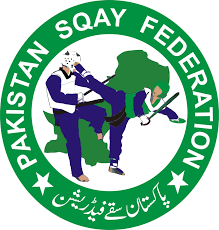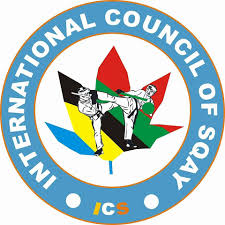
Sqay (Pakistan)
- Name of sport (game): Sqay
- Place of practice (continent, state, nation):
Pakistan, India, China
- History:
Sqay is a South Asian Martial arts form of sword-fighting originating in Ancient Kashmir. Presently divided with India Pakistan and China.
Folklore traces it to remote antiquity several thousand years ago, as far back as the ancient Kashmiri flood myth. The Shaivite snake-worshipping Naga people are said to have created the art prior to the Indo-Aryan invasions, and it was later patronised by kings. The first written evidence of sqay dates to the Muslim period when Persian writings told of sabre-fighting (shamsherizen) in Kashmir. The word sqay itself is first recorded in this period, and is said to mean "knowledge of war" in Persian. Sqay first began to decline in the colonial period but its popularity suffered more during the post-independence Kashmir conflict. In the 1980s, the sqay Grandmaster Mir Nazir Ahmed feared that the art would go extinct, and so introduced modern types of competition influenced by karate and taekwondo. The subsequent founding of the International Council Of Sqay and the Sqay Federation Of India have allowed the system to be promoted on a national level. It is now taught in twenty seven Indian states as well as Bhutan and Kathmandu, Nepal, Bangladesh, Sri Lanka, Jordan, Syria, Turkey, Azerbaijan, Uzbekistan, Thailand, Iran, Iraq, Georgia.
- Description:
Armed sqay makes use of a curved single-edge sword paired with a shield, or one sword in each hand. Unarmed techniques incorporate kicks, punches, locks and chops. Sqay have different techniques single sword double sword free hand techniques and lessons of both free hand and sword.
Sqay competition typically involves sparring, breaking and preset routines. Competitors use a stick to simulate a sword, paired with a shield. Specifics of the regulations differ slightly between gender and age groups, such as the size of the arena or the duration of a bout.
Under the International Council Of Sqay's rules, the sword (tora or tura) is made of synthetic fibre covered in leather. Depending on age group, it measures 2-2.6 feet long. The sword is paired with a shield (bargula) measuring 9-10 inches in diameter, also covered in leather. The official uniform is blue, sometimes with red or yellow piping, consisting of trousers and a cross-front jacket with a belt around the waist. Chest and head guards are required only for sparring.Sparring (loba) takes place in a 5-6.5 metres square. Matches are divided primarily by age but also by weight. A dre (equal to 3 points) is awarded for well performed mavashi kick (on either side of the headguard). If a maygiri kick is executed effectively on the stomach area, a dha (2 points) is awarded. A yaw (1 point) is awarded if the competitor performs a well timed stick (tora or tura) attack. Using excessive force, even to legal scoring areas, results in a penalty or disqualification.
The arms, legs, head and upper body are all legal targets. Only strikes with the "blade" of the stick and the foot below the ankle are allowed. The eyes, groin, hips, knees and uncovered skin are off-limits. The referee can give penalties at any time for ring-outs (kokoday), dropping the sword or shield, or hitting an area not recognized as a target. A muko (warning, deduction of 1 1/2 points) is given for breaking a rule once, followed by a dasi muko (strong warning, deduction of 3 points) for the second offense and an owaza (disqualification) for the third.
If a competitor manages to gain 9 points, they are immediately declared the winner and the match ends. Otherwise, the contestant with more points wins the match. Each bout is 3–5 minutes long and may be extended by 5–7 minutes in the case of a tie. In the event of a tie at the end of the extended time, a sudden death round is held. In this round, the first competitor to score a point wins the match.The breaking (mathol) of objects is used for both training and demonstration. Any item except glass may be broken, but the most common objects are boards of wood or stone. Competitors are judged on their technique, form, quantity of items broken, and how cleanly the item(s) is broken. Scores are given on a scale of 10. Breaking in competitions is divided into the individual and team categories. The duration given for each individual or team is 3 minutes. In the team category, the group is judged as a whole using the same point method as the individual category.
Forms or khawankay are preset patterns of movements designed to improve muscle memory so the moves can eventually be performed in combat without thinking. Because modern sparring allows only a limited number of basic attacks, the majority of sqay techniques are now only taught through these sequences. In competition, khawankay are demonstrated in a 5-metre square. Competitors are judged on stance, timing and perfection of form. The team category is performed by three practitioners. Khawankay may be done with a single sword or a pair. Techniques are mainly cuts but also include thrusts. In the case of the single-sword, it is alternately held with one or both hands, depending on the move.
- Current status:
Parcticed
- Contacts:
Pakistan Sqay Federation - https://pakistansqayfederation.blogspot.com

International Council of Sqay - https://www.facebook.com/International-Council-of-SQAY-174556529319770/

- Sources of information :
Source of photos used in this article and gallery:
https://www.yogems.com/event/64th-national-school-game-sqay-martial-art-championship-2019-01
https://www.dailyexcelsior.com/j-odisha-on-2nd-spot/page14-1-1146/
https://nicelocal.in/nagpur/fitness/sqay_martial_art_club/
https://csam.online/2018/11/11/8-arti-marziali-indiane-scomparse-sqay/ - Gallery:

